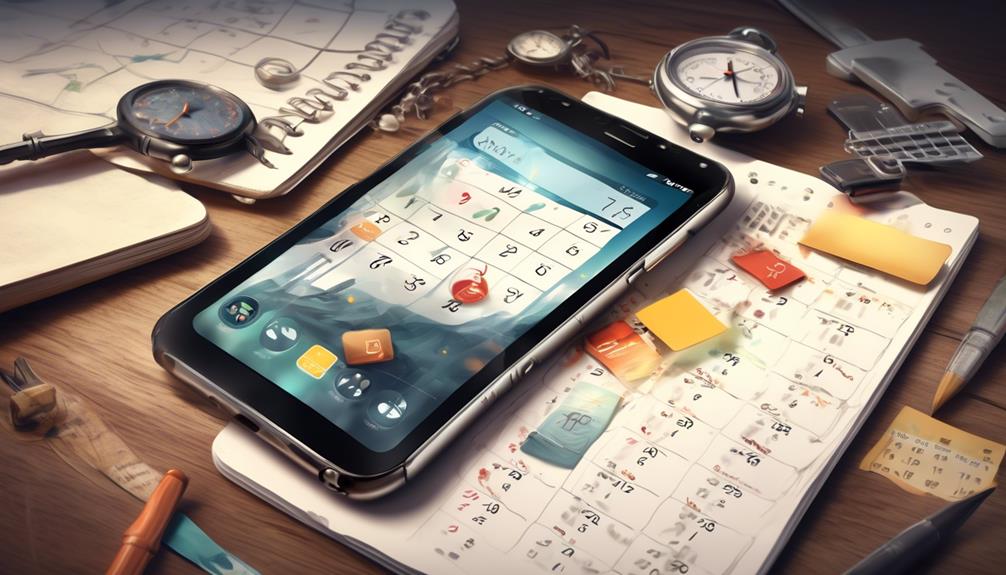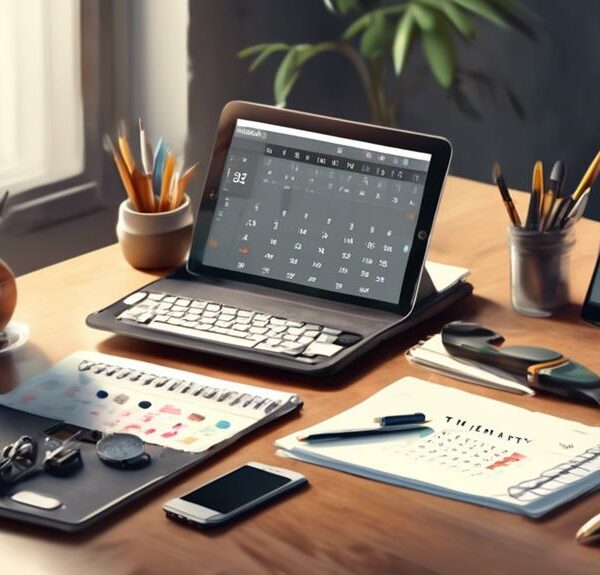So, you think you've mastered the art of time management, huh? Well, get ready to be pleasantly surprised, because we've got 13 game-changing strategies that will take your productivity to a whole new level.
These time-saving techniques will help you make the most of your resources, allowing you to accomplish more in less time. But don't worry, we won't just leave you hanging with a vague promise of increased efficiency.
In this discussion, we will delve into each strategy, providing you with practical tips and insights that you can start implementing right away.
Get ready to supercharge your productivity and make every second count.
Prioritize Tasks Effectively
To effectively prioritize tasks, start by assessing their urgency and importance. Not all tasks are created equal, and it's crucial to identify which ones require immediate attention and which ones can be put on the back burner. Urgency refers to how soon a task needs to be completed, while importance is a measure of its impact on your goals and objectives.
Begin by making a list of all the tasks you need to accomplish. Then, evaluate each task based on its urgency and importance. Assign a priority level to each task, with high priority for tasks that are both urgent and important, medium priority for tasks that are either urgent or important, and low priority for tasks that are neither urgent nor important.
As you assess the urgency and importance of each task, keep in mind your overall goals and objectives. Focus on tasks that align with your long-term vision and have a significant impact on your success. By prioritizing tasks effectively, you can ensure that you're investing your time and energy in the right activities that will yield the greatest results.
Streamline Your Workflow
Maximizing your resources starts with streamlining your workflow to ensure optimal efficiency. By streamlining your workflow, you can eliminate unnecessary steps and focus on what truly matters. To begin, take a close look at your current processes and identify any bottlenecks or areas for improvement. Look for redundancies or tasks that can be automated or delegated. This will free up your time and allow you to concentrate on more important tasks.
Next, create a clear and organized system for managing your tasks. Prioritize your to-do list based on urgency and importance. Break down bigger projects into smaller, manageable tasks and set deadlines for each one. This will help you stay on track and prevent overwhelm. Additionally, consider using productivity tools or project management software to help you stay organized and collaborate with your team more effectively.
Another way to streamline your workflow is to eliminate distractions. Identify common distractions in your work environment and take steps to minimize or eliminate them. This could involve turning off notifications on your phone or computer, setting specific times for checking emails, or creating a designated workspace free from distractions.
Lastly, continuously evaluate and refine your workflow. Regularly assess your processes and look for areas where you can make further improvements. Stay open to new ideas and technologies that can enhance your productivity. By streamlining your workflow, you can maximize your resources and achieve greater efficiency in your work.
Delegate Responsibilities Wisely
Delegate responsibilities wisely to effectively maximize your resources and achieve optimal efficiency. When it comes to managing your workload, it's crucial to recognize that you can't do everything on your own. Delegating tasks not only lightens your load but also allows you to focus on more critical responsibilities. However, it's essential to delegate wisely, ensuring that the right tasks are assigned to the right people.
Start by assessing the skills and strengths of your team members. Identify their areas of expertise and delegate tasks that align with their abilities. This approach won't only ensure efficient completion of tasks but also empower your team members to showcase their skills.
Communication is key when delegating responsibilities. Clearly define the expectations, deadlines, and desired outcomes. Make sure everyone understands their roles and responsibilities to avoid confusion or duplication of efforts. Regular check-ins and feedback sessions will help you stay updated on the progress and address any challenges that may arise.
While delegation can be beneficial, it's important to strike a balance. Over-delegating can lead to a loss of control and quality, while under-delegating can lead to burnout and inefficiency. Find the right balance by considering the workload, skill level, and availability of your team members.
Use Technology to Your Advantage
Leverage the power of technology to streamline your processes and boost productivity. In today's fast-paced world, technology plays a vital role in enhancing efficiency and saving time. Take advantage of various tools and software available to automate repetitive tasks, allowing you to focus on more important aspects of your work.
One effective way to use technology to your advantage is by utilizing project management software. These platforms enable you to plan, organize, and track your projects in real-time. With features like task assignments, deadlines, and progress tracking, you can ensure that everyone on your team is on the same page and working towards the same goals.
Another useful tool is cloud storage. Instead of wasting time searching for documents or dealing with physical paperwork, store your files securely in the cloud. This allows for easy access, collaboration, and sharing, even when you're not in the office. Additionally, cloud-based file storage eliminates the risk of losing important information due to hardware failure or accidents.
Communication tools such as instant messaging and video conferencing also contribute to time savings. Instead of scheduling lengthy in-person meetings, you can communicate and collaborate with team members or clients from anywhere, at any time. This reduces the need for unnecessary travel and allows for quicker decision-making.
Set Realistic Goals and Deadlines
To continue optimizing your time and resources, it's important to establish realistic goals and deadlines. Setting goals that are too ambitious can lead to frustration and burnout, while setting deadlines that are too tight can result in poor quality work. By setting realistic goals and deadlines, you can ensure that you're able to effectively manage your time and utilize your resources efficiently.
When setting goals, it's crucial to be specific and measurable. Vague goals can leave you feeling unsure of what exactly needs to be accomplished, whereas measurable goals provide clear criteria for success. For example, instead of setting a goal to 'increase sales,' you could set a goal to 'increase sales by 10% within the next quarter.' This specific and measurable goal allows you to track your progress and make adjustments as needed.
In addition to setting realistic goals, it's equally important to establish deadlines that are achievable. Consider your workload and the available resources when setting deadlines. Avoid overcommitting yourself or your team by taking into account any potential roadblocks or unforeseen circumstances that may arise. Remember, it's better to set a slightly longer deadline and deliver high-quality work, rather than rushing to meet an unrealistic deadline and compromising on quality.
Minimize Distractions and Stay Focused
Stay focused and minimize distractions to make the most of your time and resources. In today's fast-paced world, it's easy to get sidetracked and lose sight of what really matters. However, by taking steps to minimize distractions, you can stay focused and accomplish more in less time.
One of the first things you can do to minimize distractions is to create a dedicated workspace. Find a quiet area where you can work without interruptions. Remove any unnecessary items from your workspace that may tempt you to lose focus. Keep your phone on silent or in another room to avoid the constant buzzing and notifications that can disrupt your workflow.
Another effective strategy is to prioritize your tasks. Make a to-do list and focus on the most important tasks first. By tackling the most pressing tasks early on, you can avoid feeling overwhelmed and ensure that you're making progress towards your goals.
Additionally, practicing mindfulness and staying present can help you stay focused and minimize distractions. Avoid multitasking and instead, give your full attention to one task at a time. Set specific time blocks for checking emails or browsing social media to prevent these activities from becoming major distractions.
Automate Repetitive Tasks

Save time and increase efficiency by automating repetitive tasks.
Automating repetitive tasks can be a game-changer when it comes to maximizing your resources. By using technology to automate these tasks, you can free up valuable time and energy to focus on more important and strategic activities.
One way to automate repetitive tasks is by utilizing software or tools that can perform these tasks automatically. For example, you can use email automation tools to send out pre-written responses or schedule emails to be sent at specific times. This can save you the hassle of manually typing and sending individual emails, allowing you to respond to inquiries and messages more quickly and efficiently.
Another way to automate repetitive tasks is by creating templates or standardized processes. Instead of reinventing the wheel every time, you can create templates for common tasks or documents and simply customize them as needed. This can significantly reduce the time and effort required to complete these tasks, ensuring consistency and accuracy.
Additionally, consider using task management or project management tools to automate workflows and streamline collaboration. These tools allow you to assign tasks, track progress, and automate notifications and reminders, ensuring that everyone stays on track and nothing falls through the cracks.
Optimize Your Workspace for Efficiency
Maximizing the efficiency of your workspace is crucial for ensuring that you can make the most of your time and resources. By optimizing your workspace, you can create an environment that promotes productivity and allows you to accomplish tasks more efficiently.
Start by decluttering your workspace and keeping only the essentials within reach. Remove any unnecessary items that may distract you or take up valuable space.
Organize your supplies and materials in a way that's logical and easy to access. Use storage solutions such as shelves, bins, or drawer organizers to keep everything tidy and within reach.
Additionally, consider the layout of your workspace. Arrange your desk, chair, and computer in a way that allows for comfortable and efficient movement. Ensure that your workspace is well-lit and free from distractions.
Use desk organizers or cable management systems to keep cords and cables neat and out of the way.
Finally, personalize your workspace with items that inspire and motivate you. This could include pictures, quotes, or plants.
Utilize Time-Saving Tools and Apps

Make the most of your time and resources by incorporating time-saving tools and apps into your workflow. In today's fast-paced world, technology offers a wide range of applications and tools designed to streamline tasks and boost productivity. By utilizing these time-saving tools, you can work more efficiently and effectively, freeing up valuable time for other important tasks.
One essential time-saving tool is project management software. These tools allow you to organize and track tasks, set deadlines, and collaborate with team members. With features such as task assignments, progress tracking, and file sharing, project management software ensures that everyone stays on the same page and tasks are completed on time.
Another valuable tool is automation software. This technology allows you to automate repetitive tasks, such as data entry, email scheduling, and social media posting. By automating these tasks, you can save hours of manual work and focus on more important and strategic activities.
Additionally, there are numerous productivity apps available that can help you stay organized and prioritize your tasks. These apps offer features like to-do lists, reminders, and calendar integrations, making it easier to manage your time and stay on top of deadlines.
Implement Effective Time Blocking Techniques
To effectively manage your time and increase productivity, incorporate time blocking techniques into your daily routine.
Time blocking is a simple yet powerful strategy that involves dividing your day into distinct blocks of time dedicated to specific tasks or activities. By assigning specific time slots for each task, you can eliminate distractions and stay focused on one thing at a time. This technique helps you prioritize your tasks and ensures that you allocate enough time for each activity.
To implement effective time blocking techniques, start by identifying your most important tasks and scheduling dedicated time blocks for them. Make sure to allocate sufficient time for each task, considering its complexity and importance.
During each time block, eliminate distractions such as phone notifications or unnecessary interruptions. Set boundaries and let others know that you're unavailable during these dedicated blocks of time.
It is also helpful to group similar tasks together in order to minimize the mental effort required to switch between different types of activities. For example, you can allocate a block of time in the morning for emails and administrative tasks, another block for meetings and collaborative work, and a separate block for focused, deep work.
Remember to be flexible and adjust your time blocks as needed. Some tasks may take longer than expected, while others may be completed more quickly. Regularly review and update your time blocks to ensure that they align with your priorities and goals.
Practice Effective Communication and Collaboration

Now, let's shift our focus to enhancing productivity through effective communication and collaboration.
When it comes to maximizing your resources, practicing effective communication and collaboration is crucial. By fostering clear and open lines of communication, you can ensure that everyone is on the same page and working towards a common goal.
Effective communication involves not only speaking clearly and articulately but also actively listening to others. Take the time to understand what your colleagues are saying and ask clarifying questions when necessary. This will help avoid miscommunications and misunderstandings that can waste valuable time.
Collaboration, on the other hand, is all about working together towards a shared objective. Encourage teamwork and the sharing of ideas among team members. By pooling everyone's expertise and perspectives, you can come up with innovative solutions and make more informed decisions.
To facilitate effective communication and collaboration, consider utilizing technology tools such as project management software, instant messaging platforms, and video conferencing. These tools can help streamline communication, make information readily accessible, and bridge the gap between remote team members.
Learn to Say No and Prioritize Self-Care
Learning to prioritize self-care and setting boundaries by saying no are essential for maintaining your well-being and maximizing your resources. It's easy to fall into the trap of overcommitting and neglecting your own needs in the process. However, by learning to say no when necessary, you can avoid spreading yourself too thin and ensure that you have the time and energy to focus on what truly matters.
Saying no doesn't make you selfish or unhelpful; it simply means that you're taking care of yourself and being mindful of your own limits. It's important to remember that your time and energy are valuable resources, and it's okay to prioritize yourself and your well-being.
Prioritizing self-care isn't a luxury, but a necessity. It allows you to recharge, rejuvenate, and maintain a healthy work-life balance. Taking the time to engage in activities that bring you joy, such as exercising, meditating, or spending time with loved ones, can greatly improve your overall well-being and productivity.
Continuously Evaluate and Adjust Your Strategies

Regularly assess and adapt your approaches to ensure maximum efficiency and effectiveness. Continuously evaluating and adjusting your strategies is crucial in today's fast-paced world. As circumstances change and new information becomes available, it's important to stay flexible and make necessary adjustments to your plans.
Start by setting aside time at regular intervals to review your current strategies. Look for areas where improvements can be made or where your resources aren't being utilized effectively. This could involve analyzing data, soliciting feedback from team members or stakeholders, or seeking outside input from industry experts.
Once you have identified areas for improvement, take action to adjust your strategies accordingly. This may involve reallocating resources, reorganizing processes, or adopting new technologies or tools. Be willing to experiment and try new approaches to find what works best for your specific situation.
Remember that evaluation and adjustment is an ongoing process. Regularly revisit your strategies to ensure they're still aligned with your goals and objectives. As the business landscape evolves, your strategies may need to change as well.
Conclusion
In conclusion, by implementing these time-saving strategies in your daily life, you can maximize your resources and increase productivity.
Prioritizing tasks, streamlining workflows, and effectively delegating responsibilities are just a few ways to make the most of your time.
Remember to use technology to your advantage, set realistic goals, and practice effective communication and collaboration.
By continuously evaluating and adjusting your strategies, you can achieve better time management and ultimately achieve success.
So, start implementing these strategies today and watch your productivity soar.









